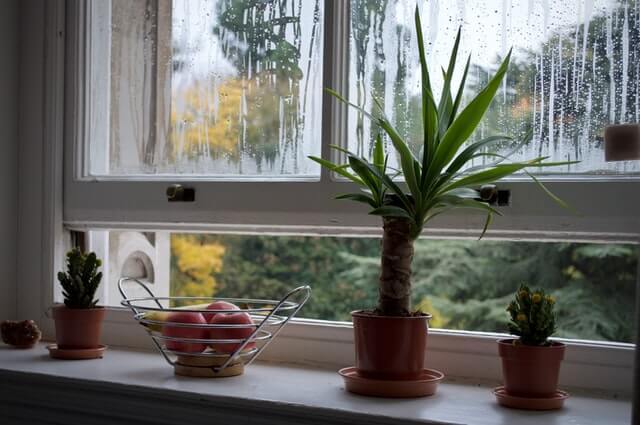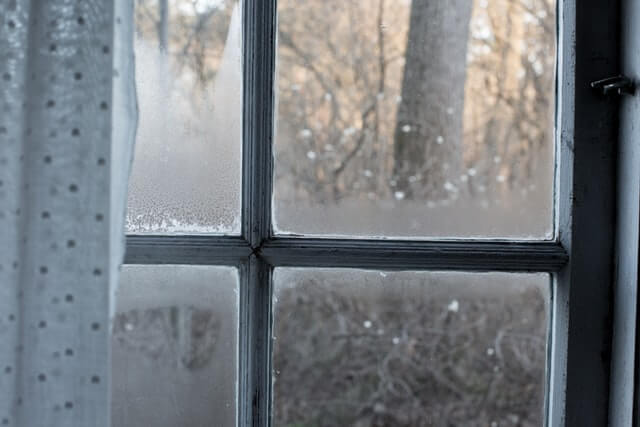
Condensation is the process of gasses changing phase into liquids. When condensation appears on windows, it comes in three varieties with varying levels of severity. Broadly, water condensation happens when moisture in the air lowers in temperature when it makes contact with a surface and forms droplets. Two primary factors at play determine if moisture in the air will condense. They are the surface temperature and the relative humidity. When surfaces are cold and/or there is lots of moisture in the air the chance of condensation forming increases.
What Are Common Window Condensation Problems?
The three types of condensation that windows experience have varying levels of severity. Moisture in the air can form droplets on the outside of your home, the glass surface inside your home, or between the panes of glass that make up the insulating unit of your window. Usually when customers have issues with condensation on their windows it is in the latter two forms. Condensation on the exterior glass surface is expected and is usually entirely harmless on aluminum and vinyl windows. Here in the Lower Mainland, exterior condensation is as common as the rain.
Condensation that appears between the panes of glass in your window is not an indicator of moisture problems. Instead, this indicates a separate issue. When moisture appears between the panes of glass the seal on the window glass is failing and is one of the key indicators that windows should be replaced.
Condensation on the inside of your home is usually what concerns most consumers. Window and door products do not cause this condensation but different products can change the frequency and severity of the appearing condensation. Generally, window glass is the coldest surface in your home. That means that if condensation issues are present, they usually show on windows first.
When Does Condensation Damage Windows?
Condensation itself does not damage windows and can be relatively minor. Unattended water issues, such as excessive condensation, do cause issues. Water is the leading antagonist to all construction projects and materials. If water pools and soaks into drywall, mouldings, or other materials, then those materials can be degraded or start to rot. The problems can cascade into issues for the windows and the integrity of the seal that windows and your building provides against the elements. These problems take time to develop. You can avoid these problems if excessive condensation is the cause. Limiting the amount of condensation that forms or collecting the condensation when it is excessive stops the immediate issues from the collecting water.
What are the Causes of Condensation?
The causes of interior condensation are environmental. The primary culprits are the circulation and moisture levels in your home. To understand why condensation is forming, you have to understand what causes changes to ventilation and changes moisture levels in a home.
Some areas of your home may be increasing the amount of moisture in the air either by maintaining those levels of moisture or by adding moisture to the air. Plants do both. They store water and slowly release that water back into the air. Hot tubs, pools, bathrooms, and people all add to the humidity levels. Depending on the age and quality of your foundation, it can also be allowing moisture to seep into your basement causing the air to carry more water in your home. Any new furniture or construction materials may also be shedding moisture into the air as they acclimatize.
How you heat and cool your home will also affect the ways that air circulates and how much humidity remains inside of your home. Many systems will allow the homeowner to tailor the humidity values. However, if you only have baseboard heaters – which is common around here – you may only be able to affect the local temperature zones and not the circulation and humidity levels. Check how your home circulates air and if your system removes moisture. If you have a passive circulation system, or no circulation system (baseboard heaters), consider other ways of controlling these conditions.

How to Reduce Condensation Risks
The general strategy for reducing the amount of condensation is to increase circulation of air and reduce the interior moisture levels. Opening windows and running a dehumidifier are sure-fire ways to combat your specific issues that increase your condensation risks. Monitor the humidity levels in your home and keep that level manageable. If your heating system allows, increase the amount of dehumidification. Consider also that window coverings may be hampering the circulation in front of your windows and increasing their chances of condensation.
What Role do Windows Play in Condensation?
It is very common that window companies will say that windows and doors do not cause condensation. While that is technically true, that statement deftly avoids the question you are asking. The type of windows that you have and the glass options used do affect the levels of humidity at which condensation is likely to form. Vinyl windows, with a “warm spacer” are the gold standard. Older windows, like old aluminum and wood windows are better conductors than vinyl. Single-glazed windows are worse conduction offenders than double-glazed, which is in-turn worse than triple-glazed. When windows conduct heat between the inside and the outside, they increase the likelihood that condensation will form on the glass. If you installed windows in the past decade then your manufacture is probably correct that the windows are not the issue.
When we install windows, it is very common that we are improving the seal of the house. That is, we close up many of the holes through which moisture may have been leaving your home. It is common that when windows which have a lower risk of condensation replace older, higher-risk windows that the improved sealing of the home cause previously free moisture exchange to stop. The condensation can often be an indicator of a well-done job! We can inadvertently increase the risks of condensation while providing a proper installation. When condensation forms on these windows, the culprits are always airflow and humidity.

FAQs
What are the best types of windows to reduce condensation?
All modern windows use technology to reduce condensation. Generally, vinyl or composites are better than wood, which is better than aluminum.
What seasons are the worst for condensation?
This will depend on where you live. Humidity is the key. When humidity is high, condensation risks are high.
Why do my new windows have condensation? My old ones did not!
This likely happens because the house is better sealed than it was with the previous windows. Your new windows may have stopped existing leaks that were allowing moisture to escape your house.
Can window coverings cause condensation?
Window coverings can reduce the airflow around windows and change the temperature of the glass.

